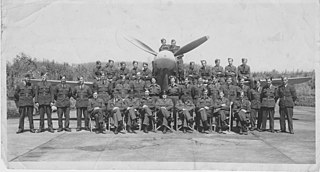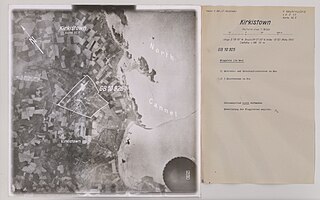Related Research Articles

The Falkland Islands are a British overseas territory and, as such, rely on the United Kingdom for the guarantee of their security. The other UK territories in the South Atlantic, South Georgia and the South Sandwich Islands, fall under the protection of British Forces South Atlantic Islands (BFSAI), formerly known as British Forces Falkland Islands (BFFI), which includes commitments from the British Army, Royal Air Force and Royal Navy. They are headed by the Commander, British Forces South Atlantic Islands (CBFSAI), a brigadier-equivalent appointment that rotates among all three services.
HMS Sealion was the name of several ships and at least one land base of the Royal Navy.

Royal Air Force Ballyhalbert or more simply RAF Ballyhalbert is a former Royal Air Force station at Ballyhalbert on the Ards Peninsula, County Down, Northern Ireland

Royal Air Force Kirkistown or more simply RAF Kirkistown is a former Royal Air Force satellite airfield located 6.3 miles (10.1 km) of Ballyhalbert, County Down, Northern Ireland.
Six ships and a naval air station of the Royal Navy have been named HMS Sparrowhawk after the bird of prey, the Eurasian sparrowhawk:
Cottesmore may refer to:

Ballyhalbert is a small village and townland in County Down, Northern Ireland. It is on the east coast of the Ards Peninsula between Ballywalter and Portavogie. It is largely residential and has a small harbour and large caravan site which was formerly a Royal Air Force (RAF) airfield, RAF Ballyhalbert, during World War II. It is within the Ards and North Down Borough. It had a population of 1,026 people in the 2011 Census, up from 447 people in the 2001 Census.
Five ships and a number of shore establishments of the Royal Navy have borne the name HMS Daedalus, after the mythical Daedalus:

701 Naval Air Squadron was a Royal Navy Fleet Air Arm squadron, which last disbanded during September 1958 at RNAS Lee-on-Solent where it was a Helicopter Trials, Communications and Fleet Requirements Unit. It initially formed during July 1936 as a Catapult Flight operating out of Malta and routinely embarking in RN ships such as, HMS Barham, HMS Malaya, HMS Valiant and HMS Warspite. By autumn 1939 it was known as 701 Naval Air Squadron but disbanded in January 1940. It was active twice more during the Second World War, between May 1940 and June 1941 on special duties and then between October 1942 and August 1943 performing anti-submarine patrols. Reforming in April 1945 it was designated a Communications Unit, operating out of Heston until disbanding in 1947. It last reformed as a Fleet Requirements Unit at HMS Daedalus, Lee-on-Solent, during October 1957.
Fourteen ships and one shore establishment of the Royal Navy have borne the name HMS Merlin, after Merlin, the wizard in Arthurian legend :
812 Naval Air Squadron was a Naval Air Squadron of the British Royal Navy's Fleet Air Arm. It was active between 1933 and 1956, and saw service in both World War II and the Korean War.

Royal Naval Air Station Eglinton was a Royal Navy airbase located 1.3 miles (2.1 km) north east of Eglinton, in County Londonderry, Northern Ireland. It opened as a Royal Air Force Station in 1941, before being transferred to the Fleet Air Arm in May 1943.
A number of shore establishments of the Royal Navy, used by the Fleet Air Arm, have borne the name HMS Goldcrest.

887 Naval Air Squadron was a Naval Air Squadron of the Royal Navy's Fleet Air Arm, which last disbanded during March 1946. It was formed as a Fleet Fighter squadron in May 1942 at HMS Daedalus, RNAS, Lee-on-Solent. The squadron embarked in HMS Unicorn during 1943 for convoy escort duties and later in the year to cover the allied landings at Salerno, Italy. At the end of 1943 it formed part of the 24th Naval Fighter Wing. 1944 saw it embark in HMS Indefatigable and the squadron saw action in operations against the german battleship Tirpitz during early 1944 and then joined the British Pacific Fleet at the end of the year. It was part of the attacks on the oil refineries at Palembang at the start of 1945 and later in the year it was involved in sorties around Tokyo, as part of the 7th Carrier Air Group, before V-J Day.

718 Naval Air Squadron was a Naval Air Squadron of the Royal Navy created on 15 July 1936 to serve as a Catapult Flight of the Fleet Air Arm. It was elevated to squadron status at the end of 1937, before being disbanded on 21 January 1940. It was re-formed on 5 June 1944 to operate as the Army Co-operation Naval Operational Training Unit before being disbanded again on 1 November 1945. On 23 August 1946 it was reformed for the third time to operate as a Seafire Conversion Squadron but was disbanded less than one year later, on 17 March 1947. On 25 April 1955, after almost a decade, the squadron was reformed once more to train RNVR on jet aircraft. Once this work was complete, it was disbanded for the final time on 31 December 1955.

768 Naval Air Squadron was a Naval Air Squadron of the Royal Navy's Fleet Air Arm (FAA). It last disbanded at HMS Gannet, RNAS Eglinton, Northern Ireland, in March 1949, having been formed as a Deck Landing Control Officer Training Squadron, in December 1948, to ensure one American-style signal trained DLCO could be located at every FAA station. It first formed as part of the Deck Landing Training School at HMS Condor, RNAS Arbroath, in January 1941, as a Deck Landing Training Squadron. Advanced training was in HMS Argus, for which a detachment was maintained at HMS Landrail, RNAS Machrihanish, where it wholly moved to in March 1943. September saw a move to RAF Heathfield, Ayr, followed by a further move to HMS Sanderling, RNAS Abbotsinch in January 1944. Training used escort carriers on the Firth of Clyde and a detachment was maintained at (Heathfield)Ayr throughout this period, with the squadron returning there in July 1945, at this time HMS Wagtail, RNAS Ayr. In August the squadron moved to HMS Corncrake, RNAS Ballyhalbert in Northern Ireland but then in October it joined up with the Deck Landing School at HMS Peewit, RNAS East Haven, Scotland, where it disbanded in April 1946.

784 Naval Air Squadron was a Naval Air Squadron of the Royal Navy's Fleet Air Arm which last disbanded in the autumn of 1946. 784 NAS was a Night Fighter Training Squadron which formed at HMS Daedalus, RNAS Lee-on-Solent, Hampshire, in June 1942, moving to HMS Nighthawk, RNAS Drem, East Lothian, in October 1942. Squadron Personnel were also detached to the Naval Air Radio Installation Unit at RAF Christchurch, in 1943 and in the same year, a number of crews were attached to RAF night fighter squadrons, with two officers gained Distinguished Flying Crosses. In 1944, three squadron Flights were attached for service to each of 813, 825 and 835 Naval Air Squadrons, embarked in the escort carriers HMS Campania, HMS Vindex, and HMS Nairana respectively, on convoy protection duties. At the beginning of 1946 the squadron moved to Wales, operating out of HMS Goldcrest II, RNAS Brawdy.

787 Naval Air Squadron was a Naval Air Squadron of the Royal Navy's Fleet Air Arm which disbanded in January 1956. It formed in March 1941, at HMS Heron, RNAS Yeovilton, out of 804 Naval Air Squadron as a Fleet Fighter Development Unit. Almost every type of fighter was received by the squadron for testing and evaluation for naval use. A move to RAF Duxford in June 1941 saw it become the Naval Air Fighting Development Unit, attached to the Royal Air Force's Air Fighting Development Unit. The squadron undertook rocket projectile test, continuous development of fighter tactics and even helping Torpedo Bomber Reconnaissance squadrons in evading fighter attack. Post Second World War it continued its trials task and also undertook Rebecca radar trials and ASH, US-built air-to-surface-vessel radar trials.

1846 Naval Air Squadron was a Naval Air Squadron of the Royal Navy's Fleet Air Arm. It formed at RN Air Section Brunswick in July 1944 as a fighter squadron, with eighteen Vought Corsair Mk III fighter aircraft. It embarked in HMS Ranee in October, disembarking to HMS Gannet, RNAS Eglinton at the beginning of November, where it expanded to twenty-four aircraft by absorbing part of the disbanded 1848 Naval Air Squadron. In February 1945, it re-equipped with Vought Corsair Mk IV, having joined HMS Colossus at the start of the year. The aircraft carrier departed for the Far East in February, and its aircraft formed part of the 14th Carrier Air Group when this formed in June at HMS Valluru, Royal Naval Aircraft Maintenance Yard Tambaram. The squadron was too late for World War II, and eventually disbanded at HMS Siskin, RNAS Gosport, in July 1946.
References
- ↑ "Ballyhalbert". Airfields of Britain Conservation Trust. Retrieved 3 November 2013.